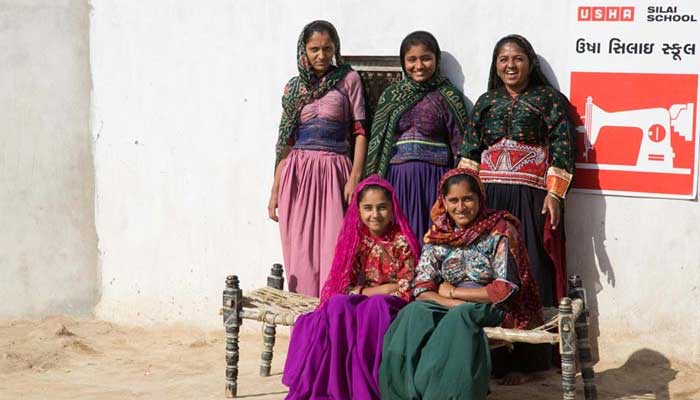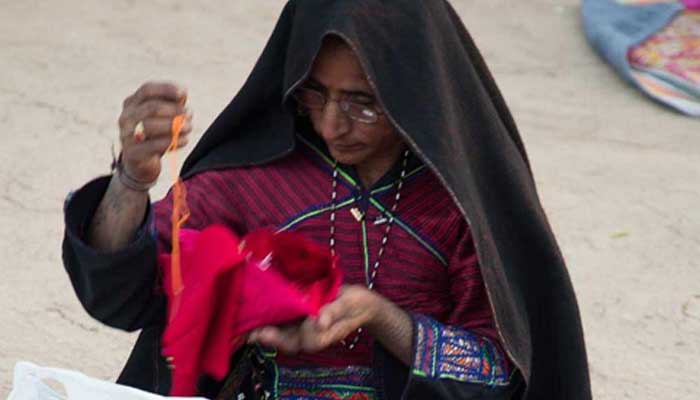- Home/
- USHA With NGOs In West Bengal Help Women Generate Income Through Traditional Stitching Art Forms
USHA With NGOs In West Bengal Help Women Generate Income Through Traditional Stitching Art Forms

Kantha is an art form passed down for generations, from one set of women to another. Often it wasn't done for commercial value but to tell stories and became a form of intricate designs with themes depicting folk art, traditional beliefs, epics and rituals. But now it is empowering women, whose lives have been touched by the USHA Silai Schools. From a pastime for women to an income generator to preserving cultural heritage. It has now evolved into an instrument of social change with the intervention of USHA Silai schools in rural areas of Bengal.
Rinku Mondal is 45 years old and has a regular job but she enjoys being an USHA Silai school teacher. Being an USHA Silai School teacher for the last eight years, she has seen her monthly income grow significantly after taking up Kantha . Speaking about her experience, USHA Silai School Teacher, Rinku Mondal said,
I love Kantha stitches. I was first trained by USHA. I was trained in embroidery, and I learnt production too. I received a certificate there and that was my first inspiration. Then, I upgraded my capabilities while working and gained experience as well. I watched others and learnt and then I started working on my own. The biggest thing is that when I made small samples, first I started working on churidars and kurtas, and when I saw that I could earn some money, I was attracted towards it. Then I tried to figure out how I could improve the work and make it more attractive and increase demand and I learnt from experience.
Also Read:
For Ms Mondal, the fact that she stays in a remote area meant that opportunities for additional income were very limited, more so for women. Ms Mondal further said,
The truth is, I stay in an absolute rural area and earning money there is a difficult task. It's not easy to make an income. Initially it was a struggle, and I was finding it tough but then I saw when I upgraded my skills with good hand stitching and cutting, slowly I saw that more people were interested and there were more buyers. A lot of people come to me now and purchase hand embroidery work. Because I am teaching the school students well then numbers have students are much higher now. I am running a school here and I run a school at home as well. Now I run schools with a lot of students and make a good income which is much better than earlier. But the lockdown has resulted in a lot of losses for us, and people are now going through a financial crunch. So, I have fallen back during the lockdown.
She has seen a huge jump in the number of students after she started teaching Kantha. Ms Mondal said that in her school, most of the students hold a lot of interest in learning the art form, and are learning it alongside their studies.
I don't know how far they will go but they are very excited. I have seen that at least 70% of girls are very interested in stitching. After I introduced Kantha stitch, I noticed a jump in the number of students. A lot of people like kantha stitches. This requires patience and those who do not have patience will avoid it. But most girls like hand embroidery. Earlier, every month I used to earn from ₹3000 to ₹3500 but now that has reached ₹9000 to ₹10000. You can imagine how much I have been able to increase it. The credit goes to USHA and the efforts I have put in.
Also Read:
For Rinku's sister, Tinku Mondal Adhikary, life has been even more difficult. A difficult marriage and her separation meant she needed an income to support her children. Kantha came to the rescue. USHA Silai School Teacher, Ms Adhikary said,
In 2014 I started having issues in my family and I left with my kids in the middle of 2014, sometime in March/April. I had to do something as I had two children. I had to run my family and I had to become independent. I had an interest in stitching and I knew some basic stitching and I enrolled in the USHA programme. I learnt stitching at USHA and the kantha stitch was easy as it was hand embroidery as I could afford to buy a machine. I learnt hand embroidery and kantha stitch and I started working on sarees and kurtas. (PATCH)Now there is USHA school and I have a lot of students.
She says while stitching was supporting her family, it was Kantha that really gave her the extra earning she badly needed. Ms Adhikary said,
What has happened now which is different from earlier is that we are working on making it look good. Everyone wants a good kantha stitch including the girls who are making the churidars themselves and then working on the kantha stitch. From the kantha stitch work that I do, I earn around ₹4000 to ₹5000 which is beyond the earning that I have from the school.
Also Read:
Local NGOs say the initiative has made a huge difference in the lives of those who need the support. Human Development Centre, NGO Partner, Suchita Das said,
When USHA brought this opportunity to us, we found out who needs it the most. We were focussing on oppressed women whose husbands did not look after them. There are a lot of families that are big, but they do not have enough income. There we noticed that if we can support them with additional incomes through the stitching they learn at USHA, the families can stand on their feet and the children can be looked after. The big families cannot run on one person's income. We first identify them and then we speak to them. We then appeal to them to come and join the USHA Silai School.
For USHA, the effort to use Kantha, an art form often passed down through generations, is an example of the success of its community-based initiatives with the aim of empowering village women to become entrepreneurs. Regional Manager of USHA International Limited, Saikat Nasker said,
Kantha stitch is a very popular and traditional art form in eastern India. Especially in rural West Bengal, we have seen that Kantha stitch is a very popular art form. We also notice these skill sets in women in West Bengal. The USHA Silai school entrepreneurs during their training are being oriented in the basics of embroidery. After this they take their skills to the next level by displaying creativity and innovation and they impart the kantha stitch skills to the other learners who come and enrol in the USHA Silai school. So, they make lots of various creative items on mats, sarees, and the various cloth materials which the women wear. So, we have noticed that there is a minimum three-fold increase in the income of the women who impart kantha stitch skills in the USHA Silai school platform.
The success of teaching women Kantha through the USHA Silai Schools in these areas is an example of helping them develop their inherent latent potentials. And helping women become self-sufficient and earning members of their families, will go a long way in bringing about holistic development for society at large.
Also Read:
also read
Threads Of Courage: Usha Silai School's Kushalta Ke Kadam Weaves Dreams Into Reality
Team NDTVStitching New Beginnings: How Usha Silai Schools Transformed Three Women's Lives
Written by Team NDTVUSHA x NDTV: From Uttar Pradesh To Bihar, Corporate Partnerships Drive Financial Freedom For Rural Women
Team NDTV
Related Stories
More- Team NDTV | Wednesday January 07, 2026
From Madhya Pradesh's stigma to Bihar's child marriages, Usha Silai School's NDTV-backed Kushalta Ke Kadam empowers women like Kalpana and Shabnam to stitch dignity and self-reliance
- Written by Team NDTV | Friday January 02, 2026
Usha Silai Schools give second chances to women like Srinagar's Marifat, who rebuilt after widowhood; Madhya Pradesh's Jyoti, escaping abuse to run her own center; and Rajasthan's Vimla, rising from child marriage to tailor and teacher. Through nine-day training, they gain sewing skills, confidence, and income proving one stitch mends lives and inspires communities.
- Team NDTV | Friday December 26, 2025
A new wave of corporate-community partnerships is equipping rural women with skills, income and confidence
- Written by Team NDTV | Friday December 12, 2025
USHAs Silai School Programme empowers women across India by turning sewing into independence. Women become trainers and leaders, transforming their lives and communities through skills, confidence, and income
Adopt a Silai School
About the Initiative

Kushalta Ke Kadam, an initiative by USHA Silai School and NDTV has entered its eighth season. The aim is to empower more women across rural India by teaching them sewing skills and helping them open new doors of opportunities for themselves. The initiative encourages rural women to become financially independent and entrepreneurs by taking up sewing and training others in their respective communities.
Since 2011, the USHA Silai School initiative has trained more than 12 lakh rural women through over 33,000 Silai schools, spanning over 20,751 villages across India.
The women earn Rs. 4,000 – 5,000 per month on an average, with the highest recorded monthly earning being Rs. 84,000 in a month. This earning works as a catalyst towards building their self-confidence, reducing gender inequities, and raising their stature within their families and in society at large.
In Pics

Rebari girls grow up learning traditional embroidery, which along with their new found sewing skills developed at Usha Silai Schools, is helping them earn a living.

Usha Silai School has empowered many rural women to support their family and send their children to school.

The Usha Silai School, established in a small nondescript village that goes by the name of Kottai, is helping empower people from varied communities.

The all-inclusive Usha Silai School Programme covers the entire nation from hamlets tucked between hills to villages cast by the sea.

Vegetables farmers from the Mizoram hills earn very little given the topography of the area. Usha Silai Schools have played an important part in this region by skilling women to financially contribute towards their households.

Usha Silai School learner Lucy has trained seven other women in her community, helping them to become financially independent.

Women like Kaviben from the nomadic Rebari community are finally laying down their roots as they begin to gain financial independence and thereby stability through Usha Silai School.

Usha Silai School, located in the Gujarat's Bhuj village, is enabling rural women to earn as much as Rs. 2,500-4,000 each month.

Usha Silai School, in association with a Gujarat based NGO called Kala Raksha, is trying to bring about a Silai revolution in Bhuj.

Besides training other women from their community, many Usha Silai School learners have become entrepreneurs in their own right.

With sewing becoming easily accessible and lucrative, the silai schools are also helping revive traditional motifs and designs.






